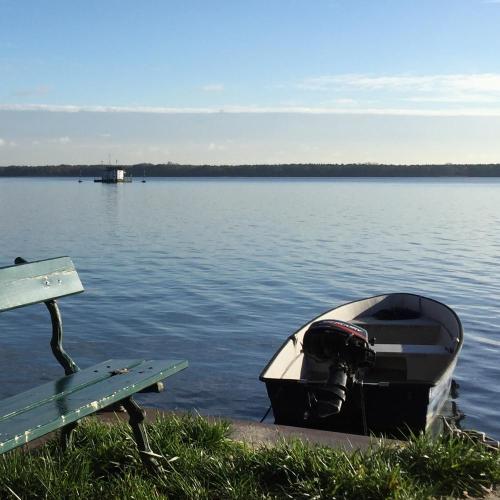
Songjun Wu
Müggelseedamm 310, 12587 Berlin
Profil
Education:
2012-2016, Bachelor of Science in environmental science, Nanjing Normal University
2016-2019, Master of Science in environmental science, Nanjing Normal University
Since 2019, PhD candidate in ecohydrology, Leibniz Institute of Freshwater Ecology and Inland Fisheries Berlin
PhD Topic
Tracer-aided monitoring and modelling of catchment-scale ecohydrological processes and its implication for water quality
Zielsetzungen
1. Investigating the impacts of long-term hydroclimatic change and riparian management on hydrology and water chemistry in a mixed land use catchment, and identifying the hot spot area of the hydro-chemical functioning
2. Exploring the hydrology, isotopes, water chemistry and vegetation phenology in a higher spatiotemporal resolution in a riparian peatland (the hot spot area)
3. Quantifying the hydrological and water quality fluxes in both catchment and hot spot area using distributed hydrological/water quality modelling
Methode
Multiple approaches are used to realise the objectives, including:
1. Dense field sampling of water isotopes, water quality indices
2. Hydrological and water quality modelling (mHM-Nitrate, and EcH2O-iso for plot or catchment-scale modelling)
3. Technologies of unmanned aerial vehicle (UAV) and geographic information system (GIS) for ultra-high resolution multispectral imagery and DEM
4. Deep learning approach for vegetation classification and soil moisture estimation based on UAV imagery
Konferenzen
AGU Fall Meeting, 2020, H056-0022. (Poster)
Wu, S., Tetzlaff, D., & Soulsby, C. (2020). Long-term Monitoring Shows that Climatic Variability and Riparian Management Control the Coupling of Hydrology and Nutrient Concentrations in a Mixed Land Use Lowland Catchment.
AGU Fall Meeting, 2021, H13C-08. (Oral presentation)
Wu, S., Tetzlaff, D., Yang, X., Soulsby, C., Wu, S., Tetzlaff, D., et al. (2021). Unravelling the role of landscape characteristics, hydroclimate and water management on NO3-N cycling via a 30-year distributed modelling in a lowland catchment.
EGU General Assembly Conference, EGU22-46. (Oral presentation)
Wu, S., Tetzlaff, D., Yang, X., & Soulsby, C. (2022). Landscape characteristics, hydroclimate and management control spatiotemporal NO3-N patterns in a lowland catchment: implication from 30-year modelling and sensitivity analyses.
IGB Publikationen
Wu, S., Tetzlaff, D., Goldhammer, T., & Soulsby, C. (2021). Hydroclimatic variability and riparian wetland restoration control the hydrology and nutrient fluxes in a lowland agricultural catchment. Journal of Hydrology, 603. https://doi.org/10.1016/J.JHYDROL.2021.126904
Wu, S., Tetzlaff, D., Yang, X., & Soulsby, C. (2022). Disentangling the influence of landscape characteristics, hydroclimatic variability and land management on surface water NO 3 ‐N dynamics: spatially distributed modelling over 30 years in a lowland mixed land use catchment. Water Resources Research. https://doi.org/10.1029/2021WR030566
Wu, S., Tetzlaff, D., Yang, X., & Soulsby, C. (2022). Identifying Dominant Processes in Time and Space: Time-varying Spatial Sensitivity Analysis for a Grid-based Nitrate Model. Water Resources Research, e2021WR031149. https://doi.org/10.1029/2021WR031149
Wu, S., Tetzlaff, D., Goldhammer, T., Freymueller, J., & Soulsby, C. (2022). Tracer-aided identification of hydrological and biogeochemical controls on in-stream water quality in a riparian wetland. Water Research, 222, 118860. https://doi.org/10.1016/J.WATRES.2022.118860
Wu, S., Tetzlaff, D., Daempfling, H., & Soulsby, C. (2023). Optimising vegetation mapping strategies for ecohydrological applications: insights from monthly UAV-based classification in a heterogenous wetland. Journal of Hydrology. (In review)
Wu, S., Tetzlaff, D., Yang, X., Smith, A., & Soulsby, C. (2023). Quantifying flow paths in a riparian wetland using isotope-aided multi-criteria calibration of a distributed ecohydrological model. Water Resources Research. (In revision)
Andere Publikationen
Wu, S., Zhao, Y., Chen, Y., Dong, X., Wang, M., & Wang, G. (2019). Sulfur cycling in freshwater sediments: A cryptic driving force of iron deposition and phosphorus mobilization. Science of the Total Environment, 657, 1294–1303. https://doi.org/10.1016/J.SCITOTENV.2018.12.161
Landgraf, J., Tetzlaff, D., Wu, S., Freymüller, J., & Soulsby, C. (2022). Using stable water isotopes to understand ecohydrological partitioning under contrasting land uses in a drought‐sensitive rural, lowland catchment. Hydrological Processes, 36(12). https://doi.org/10.1002/HYP.14779
Yan, X., Thieu, V., Wu, S., & Garnier, J. (2022). Reservoirs change pCO2 and water quality of downstream rivers: Evidence from three reservoirs in the Seine Basin. Water Research, 213. https://doi.org/10.1016/J.WATRES.2022.118158
Yan, X., Xu, X., Wang, M., Wang, G., Wu, S., Li, Z., et al. (2017). Climate warming and cyanobacteria blooms: Looks at their relationships from a new perspective. Water Research, 125, 449–457. https://doi.org/10.1016/J.WATRES.2017.09.008
Yan, X., Xu, X., Ji, M., Zhang, Z., Wang, M., Wu, S., et al. (2019). Cyanobacteria blooms: A neglected facilitator of CH4 production in eutrophic lakes. Science of the Total Environment, 651, 466–474. https://doi.org/10.1016/J.SCITOTENV.2018.09.197
Zhao, Y., Wu, S., Yu, M., Zhang, Z., Wang, X., Zhang, S., & Wang, G. (2021). Seasonal iron‑sulfur interactions and the stimulated phosphorus mobilization in freshwater lake sediments. Science of the Total Environment, 768. https://doi.org/10.1016/J.SCITOTENV.2020.144336

